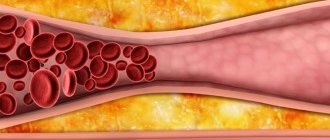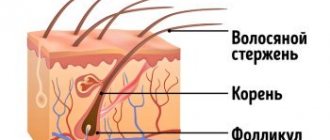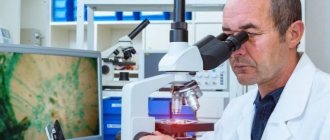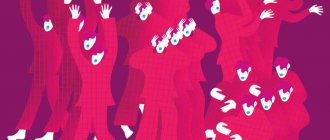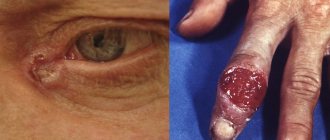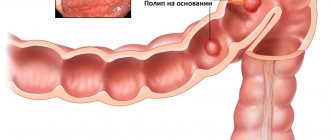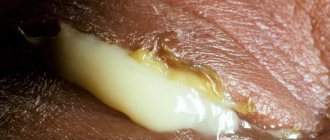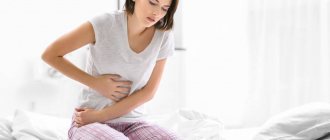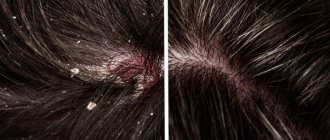From this article you will learn:
- Description of androgenetic alopecia
- The effect of androgens on hair condition
- Risk factors for developing androgenetic alopecia
- Symptoms of androgenetic alopecia
- 2 types of androgenetic alopecia
- Diagnosis of androgenetic alopecia
- 3 Ways to Treat Androgenetic Alopecia
- Drug therapy for androgenetic alopecia
- Treatment of androgenetic alopecia in men and women
- Laser therapy
- Mesotherapy and hair transplantation
- Treatment of androgenetic alopecia with traditional methods
Androgenetic alopecia is a special type of baldness that affects both men and women. This disease occurs due to hormonal imbalances that provoke intense hair loss in certain areas of the head. In the stronger half of humanity, such thinning of hair appears after 30 years, and in women after 50.
Various methods are used to treat alopecia, including medications, physical therapy, and surgery. The method of therapy is selected by the doctor depending on the causes of the disease.
Description of androgenetic alopecia
Alopecia is baldness. Androgenetic alopecia is a disease caused by increased sensitivity of hair follicles to dihydrotestosterone, the active form of the male sex hormone testosterone.
This hypersensitivity of the follicle to testosterone is a genetic disorder, which in 75% of cases is transmitted to the child from the mother. Medicine believes that androgenetic alopecia is a hormonal disease that can be hereditary.
Recommended articles on the topic:
- Diffuse alopecia in women
- Plasma therapy for the scalp
- Useful vitamins for hair: against hair loss and for growth
Androgenic (androgenetic) alopecia in men begins to develop in the frontal and parietal regions. Women first lose hair in the area of the central parting, then the hair thins on the top of the head. At the very beginning, the disease manifests itself in thinning hair and deterioration in its appearance. They become dull, lifeless and then fall out. Androgenetic alopecia is difficult to diagnose at first because it develops very slowly. The first signs of pathology appear only at the age of 30, and baldness becomes noticeable only after 10–15 years.
Many people note that with complete baldness of the frontal and parietal parts of the head, the back of the head remains covered with thick hair. This is a characteristic sign of androgenetic alopecia and is due to the fact that the follicles in this area are not sensitive to changes in the level of dihydrotestosterone in the human body.
Introduction
Androgenetic alopecia (AGA)
is a complex polygenic multifactorial condition that is the most common form of hair loss, affecting up to 80% of men and 50% of women during their lifetime. AGA develops over the years and is a reflection of segmental or organ-specific premature aging.
Genetic studies of this disease have once again highlighted the role of inheritance
. In this regard, a recent analysis of published genetic studies of AGA revealed a novel association of AGA and rs7349332, located in the intronic region of WNT10A, thereby suggesting the involvement of WNT signaling in the etiology of AGA. In a German case-control study of AGA, it was shown that one of the reasons for the genetic risk of developing AGA is a pronounced polygenic component. This fact likely reflects the complexity of the biological pathways associated with AGA.
Genetic testing
Currently, it is believed that AGA is a genetically multifactorial trait with a complex genetic structure.
The "usual suspect" gene on the "androgen side" in this case is the androgen receptor gene ( AR
), which is located on chromosome X, which may explain maternal transmission of AGA.
It is still unclear which genes other than AR
are responsible for AGA. Patients should be aware that current genetic testing is based on AR gene variations, when in fact the onset of androgenetic alopecia is caused by polygenic involvement of other genes or epigenetic mechanisms
Clinical phenomenology
AGA is a continuous, protracted process rather than a series of distinct disease phases, and each patient is characterized by a wide range of different features. As AGA progresses, it behaves similarly to the process of tissue aging - in the hair follicles, as in other organs, the proportion of cells that have only a structural function increases, sutures, constrictions, scars are formed, sclerosis occurs - increased development of connective tissue components, which leads to the weakening of specific functions, thinning and hair loss
Backward displacement of the frontal growth line and baldness of the crown are the main signs of male androgenetic alopecia. In addition, areas of alopecia may merge into a single whole, leaving only a border of normal hair growth on the sides and back of the scalp.
AGA in women progresses more slowly, is less severe, and demonstrates greater variability in response to therapy.
In women, there are three different models of AGA:
- diffuse thinning of the crown area while maintaining the frontal hairline (Ludwig model
);
- thinning and spread to the central part of the scalp with disruption of the frontal hairline (christmas tree model
);
- thinning associated with bitemporal bald patches (Hamilton model
), more often observed in menopausal women and in women with hyperandrogenism.
Androgenetic alopecia syndromes
In rare cases, extremely severe androgenetic alopecia or its early onset may be a symptom of a complex genetic disorder, such as
- trichorinophalangeal syndrome;
- progeria;
- Laron syndrome;
- and Kurshman-Steinert-Batten myotonic dystrophy.
Premature baldness
Androgenetic alopecia, the clinical signs of which appear between the ages of 10 and 20 years, is called premature or early baldness. In children before puberty, the disease, in both boys and girls, manifests itself exclusively as female pattern baldness.
Differential diagnosis of congenital hair loss includes:
- simple hypotrichosis;
- and ectodermal dysplasia (with concomitant delay in physical/mental development, sweating, abnormalities of nails and teeth).
Evolution of classifications
Determining the severity of androgenetic alopecia is challenging.
The top row shows four drawings carved on the walls of a primitive cave. It took about 30 thousand years to classify the pattern of hair loss in men, shown in the bottom row. Currently, various classification methods have been developed and modified.
AGA classifications
Until recently, the generally accepted standard was the Hamilton-Norwood classification
(1951-1975) for men and
Ludwig's classification
(1977) for women, emphasizing gender heterogeneity.
Evolution or revolution?
There was a need to improve existing classifications, as a result of which a universal classification was created in 2007. In 2007, Lee et al. proposed the basic and specific (BASP) classification system, which is an improved version of the Norwood-Hamilton classification, including four basic types (L, M, C, U) and two specific types (F and V).
| Basic and specific (BASP) classification for pattern hair loss (From: Lee WS, Ro BI, Hong SP et al (2007) A new classification of pattern hair loss that is universal for men and women: basic and specific (BASP) classification. J Am Acad Dermatol 57(1):37–46) |
The new classification of typical hair loss is a universal tool used for both men and women: the basic and specific (BASP) classification.
It can be used to assess both the further extent of hair loss and the response to therapy. By improving on the shortcomings of existing classifications, it is easier to remember and easier to apply in clinical settings. The Norwood-Hamilton classification does not take into account some specific types of hair loss, such as female pattern hair loss.
Additionally, the Ludwig scale cannot be used to classify male pattern baldness in women. BASP, regardless of gender or race, allows you to classify all varieties of hair loss types.
Reasons for the development of AGA
The development of AGA is based on gender homogeneity, which is associated with the genetic characteristics of androgen metabolism in the hair follicle.
The most significant factor in men is increased activity of the enzyme 5-alpha reductase type II, which metabolizes testicular testosterone into dihydrotestosterone (DHT) in genetically predisposed hair follicles.
In women, as a rule, a major role is played by a decrease in the activity of aromatase, which converts ovarian testosterone circulating in the blood into 17 beta-estradiol.
An increase in local DHT concentration leads to a progressive reduction in anaphase due to a longer telogen phase and is accompanied by progressive miniaturization of the HF. Miniaturization of the HF is carried out due to relatively sharp reductions in the number of cells of the dermal papilla and dermal membrane. Accompanied by:
- reduction in the absolute number of VF,
- a decrease in the period of anaphase,
- rod diameter,
- as well as increasing the duration of the kenogen phase.
The role of perifollicular inflammation
In addition to androgen-dependent changes in the pathogenesis of AGA, the involvement of follicular microinflammation with the formation of fibrosis, provoked by the presence of bacterial flora, toxins and oxidative stress, has been proven.
The effect of androgens on hair condition
Male sex hormones are collectively called androgens. They are produced in all people, but their quantity is related to gender; women have significantly less such hormones.
One of the androgens is testosterone, due to its high level in men:
- large and strong muscles;
- hair grows in large quantities not only on the head, but also on the face and body;
- mammary glands do not develop;
- a characteristic male voice, low and rough, and good stamina.
Androgens are necessary for the metabolic process and are responsible for normal sugar levels. The strength of their effect on the body differs, so androgens are divided into two groups - weak and strong. Testosterone, already familiar to us, and its weaker version, dihydrotestosterone (DHT), belong to the strong group. They are part of the enzyme 5-alpha reductase, which, with a genetic predisposition, can be present in the scalp and can cause the development of androgenic alopecia.
Despite the fact that androgens and estrogens have common metabolic processes, their effects on the body are opposite. The lifespan of hair depends on estrogen levels. One of them, estradiol, is especially actively produced during pregnancy. This is why women in interesting situations have hair that becomes thicker and practically stops falling out.
In the first weeks after childbirth, estrogen production decreases sharply, and hairs in the growth phase begin to fall out, and the hair noticeably thins.
How to treat AGA when therapy is still possible
Treatment of androgenetic alopecia is based on three rules - it is necessary:
1. protect the follicles from the negative effects of the hormone dihydrotestosterone, that is, reduce its production; 2. awaken “sleeping” bulbs, that is, stop miniaturization and restore their normal function; 3. create favorable conditions for active hair growth with a thicker diameter and dense structure.
How to stop the formation of dihydrotestosterone
The transition of testosterone to DHT occurs with the participation of the enzyme 5-falfa reductase. There is only one way to stop the transformation - by blocking the enzyme. There are two types of blockers - drugs for oral administration and external agents that need to be rubbed into problem areas.
The only drug blocker recognized by official medicine is finasteride (this is the name of the active substance, and the drugs are sold under different brand names). Finasteride has truly high effectiveness, proven by clinical trials and medical practice. But there are also nuances. Initially, finasteride tablets are a medicine to maintain the function of prostate adenoma in elderly men. That is, the drug blocks 5α-reductase in both the follicles and the prostate gland. If the dosage is chosen incorrectly, side effects may occur, ranging from decreased libido to erectile dysfunction. Such radical treatment of baldness should be carried out exclusively under the supervision of a trichologist.
5α-reductase inhibitors are also found in plants. It should be borne in mind that herbal infusions, decoctions, pepper/mustard masks and other folk remedies for baldness in men are ineffective methods of the last century. We are talking about extracts with proven beneficial effects. The list includes plants exotic for our latitudes, for example:
- palmetto;
- sweet white lupine.
External products with such extracts - sprays, lotions, shampoos for male pattern baldness - successfully block 5α-reductase and provide many other beneficial effects. For example, lupine activates vascular endothelial growth factor and the formation of new blood vessels, improving blood circulation in the skin and, accordingly, nutrition of the bulbs.
How to Wake Up Dormant Hair Follicles
An obligatory part of the therapy is to bring atrophied hair roots back to life. The officially recognized external remedy for this task is minoxidil (5% preparations are recommended for men). The beneficial effect of minoxidil is the activation of potassium channels. When the concentration of potassium in the vascular cells changes, increased synthesis of nitric oxide begins - the capillaries expand, blood flow improves, and the follicles receive more oxygen and nutrients.
Minoxidil is an effective remedy for hair growth, which is confirmed by both medical practice and patient reviews. A positive result is visible after 4–5 months of use. But there are also disadvantages. Although there is compelling evidence that minoxidil helps with male pattern baldness, you need to weigh the pros and cons before using it. Important “cons” are even greater hair thinning at the beginning of treatment and withdrawal syndrome.
Deterioration at the beginning of treatment occurs due to the fact that in problem areas there are follicles with varying degrees of degradation. At the initial stage of miniaturization, anagen lasts approximately 2 years, with dystrophy of the second and third degrees - about 1 year and 4 months, respectively. The latter are already ready to shed old hair, and under the influence of minoxidil this happens faster - the drug stimulates the growth of new hair, which pushes out the old hair shafts. That is, temporary deterioration is normal and you should not become depressed when faced with this effect. To reduce withdrawal symptoms, you need to use minoxidil for at least two years. During this time, weak vellus hair is transformed into terminal (mature) hair. Only after this can you move on to the prevention of hair loss - replace minoxidil with specialized care for baldness. Please note that the diagnosis of AGA is the constant sensitivity of the follicles to androgens. Therefore, regular shampoos/balms will have to be replaced with a care complex with 5α-reductase blockers.
Hair growth stimulants without withdrawal symptoms
There are known plants that give an effect similar to minoxidil and are safer - for example, you can stop baldness in men without withdrawal symptoms with extracts from Peruvian maca and ginkgo biloba. Ginkgo extract dilates blood vessels and helps oxygen supply tissues, regulates capillary permeability, improving lymphatic drainage and removal of metabolic products. Peruvian maca works in much the same way.
If we talk about advanced trends in the treatment of baldness, then we need to touch on the peptide topic. This topic has been known to trichologists for quite some time, but hair peptides have not yet gained the popularity they deserve among the masses - few people know what they are and how they work.
Peptides are low molecular weight fragments of protein molecules, structural analogues of natural growth factors. Peptides that enter the follicle from the outside are perceived as their own growth factors and activate self-healing processes. There are a lot of beneficial effects - under the influence of peptides, the vascular endothelium grows, dermal fibroblasts (structural cells of the skin) actively divide, the process of follicular degeneration stops, and the duration of anagen increases. Complex therapy for alopecia, which includes peptides, can be a salvation for hair, as confirmed by experts and patient reviews.
Injections for baldness
Mesotherapy - an injection treatment for alopecia - allows you to deliver active substances directly to the follicles. In terms of effectiveness, only peptide therapy can compete with injections - due to their small size, peptides easily penetrate the epidermis and membranes of follicular cells. Other substances cannot boast of such permeability. Preparations for mesotherapy for baldness have the same basis as other external remedies for hair loss and hair growth. You can give minoxidil injections or administer cocktails with extracts that block 5α-reductase. Dimethylaminoethanol (DMAE) has proven itself well - this neurotransmitter increases the energy status of the hair follicle, slows down cell aging, improves oxygen exchange, and normalizes metabolism.
Plasmotherapy (plasmolifting) also has a good effect in the treatment of androgenetic alopecia. The bottom line is that the patient's own platelet-rich plasma is injected into the scalp. The result is cell rejuvenation, tissue regeneration, strengthening of follicles, stimulation of hair growth.
Despite many positive aspects, injections have a significant drawback - injections violate the integrity of the skin, so there is always a risk of complications. And, of course, the price. Plasmolifting and mesotherapy is a course of salon procedures, the cost of which is affordable.
Risk factors for developing androgenetic alopecia
When studying the causes of androgenetic alopecia, experts identified several factors leading to the development of pathology:
- Gender. Men suffer from androgenic pattern baldness 4–5 times more often than women.
- Age. Every second man and fourth woman over 50 years old finds signs of androgenetic alopecia.
- Hormonal imbalance. Hormonal imbalance in women usually occurs after pregnancy or during treatment with medications containing male hormones. In men, the cause of alopecia can be the use of drugs that activate testosterone production, for example, various types of doping agents.
- Heredity. If androgenetic alopecia was identified in previous generations, or if relatives suffered from severe hair loss for no apparent reason, then the probability of this pathology occurring in subsequent generations is close to 80%.
- Various types of tumors and damage to the glands that produce sex hormones.
- Hyper- or hypofunction of the pituitary gland.
- Oncological formations in the adrenal glands or increased function due to certain diseases.
- Decrease or increase in the level of hormones produced by the ovaries and testicles in orchitis, polycystic disease, ovarian sclerocystosis, ovarian disease.
If the patient has at least one of the listed risk factors and his hair has noticeably thinned, then you should not postpone a visit to the dermatologist. After examination, the doctor will either decide that it is androgenetic alopecia or diagnose another cause of hair loss.
Drug therapy
Drug treatment of androgenetic alopecia involves the use of the following groups of drugs:
- dihydrotestosterone blockers;
- vitamin and mineral complexes;
- oral contraceptives that normalize hormonal levels in women;
- sedatives;
- antidepressants.
For external use, the following agents are additionally prescribed:
- hair growth stimulants in the form of lotions, sprays, masks;
- antiandrogens in the form of ointments, creams;
- copper peptides in the form of shampoos, conditioners, sprays.
Symptoms of androgenetic alopecia
Determining that hair loss is the result of androgenetic alopecia is not so easy. Symptoms may be mild; the correct diagnosis will depend on the gender of the patient and examination of the hair for pathological changes. The only characteristic sign is damage to the hair follicles only in the forehead and crown of the head, because it is in these parts of the hairline that an enzyme sensitive to dihydrotestosterone is found.
The manifestation of androgenetic alopecia in women may look like:
- decrease in hair density in the frontal and parietal parts of the head, but it does not reach complete baldness;
- changes in the menstrual cycle - androgens interfere with the work of estrogens, which causes menstrual irregularities;
- acne, usually appearing on the face and back;
- hirsutism – hair growth in places where women traditionally do not have pronounced hair (chest, back, face).
Androgenetic alopecia in men makes itself felt by sparse vegetation in only two areas of the head - frontal and parietal.
Directions for future research
Current areas of research and future therapeutic modalities include:
- stem cells of follicular origin,
- as well as technology for culturing hair follicle tissue.
Accurate identification and effective delivery of appropriate protective and triggering mechanisms that will stimulate the activation of quiescent stem cells can make prevention and reversal of hair loss possible.
Recorded based on the report of Ovcharenko Yu.S., Associate Professor of the Department of Dermatovenerology of KhMAPO, member of the board of the European Hair Research Society (EHRS), head of the Institute of Trichology clinic (Kharkov) at the VI scientific and practical conference of the non-profit partnership “Professional Society of Trichologists”.
Diagnosis of androgenetic alopecia
Sometimes androgenetic alopecia is determined based on a visual examination, since in patients with this pathology the level of hormones in the blood does not exceed normal. To exclude other possible causes of severe hair loss and determine effective treatment, diagnostic and laboratory tests are prescribed.
Types of tests for androgenetic alopecia in women and men:
- biochemical blood test - to determine the amount of microelements;
- tests for TSH, T3, T4 - for the presence of thyroid hormones;
- tests for sex hormones - to determine the level of testosterone, prolactin, estrogen;
- complete blood count and serum iron test;
- analysis for the level of adrenocorticotropic hormone (if adrenal disease is suspected).
If this is necessary, then to complete the picture, the attending physician may prescribe an ultrasound of the adrenal glands and a CT scan of the brain. The patient is referred for consultation to an endocrinologist, gastroenterologist, gynecologist, neurologist, and trichoscopy is performed.
Drugs against androgenetic alopecia
To combat androgenic alopecia, the following drugs are most often used:
- "Finaseride". Antitumor hormonal agent, produced in the form of tablets for oral use. The drug slows down the action of 5α-reductase, due to which the synthesis of dehydrotestosterone is suppressed.
- "Minoxidil." A product for external use, stops the process of hair loss, stimulates the growth and regeneration of new hair. After application to the scalp, the drug activates blood circulation, thereby improving nutrition and oxygen supply to the hair follicles. With regular use, the cells of the hair follicles regenerate, which has a beneficial effect on the growth and condition of the hair.
- "Spironolactone". A potassium-sparing diuretic that reduces the volume of fluid in the body, compensates for the lack of calcium, and normalizes the production of hormones. When treating androgenic alopecia, it slows down the synthesis of androgens in the adrenal glands, blocking their action.
- Cyproterone acetate. Reduces the activity of androgens in the body.
- Estrogen and progesterone. Specific sex hormones that are prescribed to women experiencing their deficiency.
Mesotherapy and hair transplantation
Mesotherapy is the introduction of medications directly under the skin, as close as possible to the hair follicles. For therapeutic injections, combinations of vitamins and microelements are used. This method speeds up metabolism and fills the follicles with nutrients. Hair plasma lifting works in a similar way, when instead of drugs, blood plasma taken from the patient’s vein is injected under the skin.
Painful sensations during subcutaneous injections are minimal. In terms of time, one session is about 40 minutes; to obtain a visible effect, it is necessary to carry out at least 10 procedures. For androgenetic alopecia, the drug “Dutasteride” is used for medicinal mixtures as the most effective. Almost two thirds of patients who have undergone 12 sessions of this mesotherapy note a noticeable improvement in the condition of the scalp. In the photo, androgenetic alopecia becomes almost invisible.
For those who do not like injections, mesotherapy can be performed using a mesoscooter. There will be results too, but not quickly.
Not long ago, another method of treating androgenetic alopecia appeared - hair transplantation. In the first operations, artificial or foreign hair was used as transplant material. But in the postoperative period, many complications arose in the form of purulent inflammation and rough scars. Now the patient's own hair is used for transplantation. 1-2 follicles along with pieces of skin (grafts) are taken from the occipital or behind-the-ear area.
Causes of androgenic alopecia
Androgenic alopecia is a consequence of a hormonal disorder in which the amount of androgens in the body increases. The following negative exogenous and endogenous factors can trigger the mechanism of baldness:
- Hereditary predisposition. The tendency to androgenic alopecia is transmitted at the genetic level, both on the maternal and paternal lines.
- Hormonal changes. During puberty, pregnancy, and breastfeeding, the synthesis of androgens increases, but as soon as the hormonal levels stabilize, the problem of hair loss will resolve itself.
- Endocrine disruptions. Diabetes mellitus, benign or malignant tumors localized in the adrenal glands, polycystic ovary syndrome, pituitary hyperplasia, thyroid disease negatively affect the condition of the hair follicles, disrupting their nutrition and oxygen supply, leading to destruction.
- Taking certain groups of medications. Contraceptives, glucocorticosteroids, antidepressants, potent antibiotics, diuretics, anticoagulants, anticonvulsants, if used uncontrolled, can cause damage and death of hair follicles.
- Autoimmune diseases. Autoimmune diseases often cause alopecia areata. The most common include systemic lupus erythematosus, rheumatoid arthritis, scleroderma, and trieoiditis.
- Abuse of bad habits. Alcoholic drinks and cigarette smoke poison the body, disrupt the process of assimilation of nutrients, weaken the immune system, lead to disruption of the functioning of organs and systems, weaken hair, which stops growing and begins to rapidly thin out.
- Strict diets, unbalanced nutrition. With a poor diet, the human body does not receive enough necessary nutrients, vitamins, micro- and macroelements. This leads to weakened immunity and hormonal dysfunction, which negatively affects the condition of the hair.
- Stress. Chronic stressful situations negatively affect the functioning of organs and systems, leading to serious illnesses and hair loss. After such emotional overload, the curls thin out, become dull, and stop growing in length.
- Unbalanced diet. Deficiency of vitamins, nutrients, micro- and macroelements contribute to a decrease in the body's defenses and weakening of hair follicles, which become thinner and die over time.
Treatment of androgenetic alopecia with traditional methods
Since ancient times, traditional medicine has offered various ways to strengthen hair, increase the density of curls, and reduce the rate of baldness. But all of them will give the expected effect only when used together with medications.
- Onion rub. At the first signs of thinning, it is recommended to rub a mixture of chopped onion into the hair roots. Leave the mask on for an hour and a half, then wash off with strengthening or regular shampoo. If you add crushed garlic and a little honey to the onion mass, the procedure will be even more effective.
- Pepper tincture. Grind the pepper, pour in 100 ml of vodka and leave for 24 hours. Then rub the tincture into the scalp and after an hour and a half, wash your hair thoroughly.
- Onion-cognac tincture. Grind a medium onion through a meat grinder and pour 200 ml of cognac into it. The mixture should sit for several hours. To achieve a positive result, the tincture must be rubbed into balding areas of the head daily.
- Mustard mask with castor oil. Take one tablespoon of dry mustard, mix it thoroughly with 30 ml of castor oil and let it brew for 20-30 minutes. To reduce the amount of hair falling out, a mustard mask should be applied to the scalp for 40–50 minutes. The session is carried out before each hair wash 1-2 times a week.
- Nettle lotion. The therapeutic effect is obtained by using nettle for androgenetic alopecia. In a saucepan with 5 tbsp. spoon leaves, pour 450 ml of water, add 2 tbsp. spoons of vinegar and put on the stove. Bring the mixture to a boil, keep on low heat for half an hour, then remove and cool. The product should be rubbed into the scalp every day before bed.
- Salt mask. Good results are obtained by rubbing regular or sea salt into the scalp 30–40 minutes before washing it.
- Mask with vitamins and Dimexide. Mix 2 tbsp. spoons of castor and burdock oil, add to them 1 teaspoon of vitamins A, E and 1 tbsp. spoon of Dimexide. The prepared mixture is rubbed into the roots of thinning hair and left for one hour.
- Tincture to strengthen follicles. Pour 1 tbsp into a jar. spoon of nettle and crushed burdock root, pour a glass of alcohol, add 1 bottle of alcohol tincture of mint and propolis. Close the jar tightly and put it in a cool place for a week. Then filter the composition and pour into a container with an airtight lid. Rub the resulting lotion daily before bed.
- Mask with sea buckthorn oil. Mix 1 teaspoon of sea buckthorn oil with 6–8 drops of grapefruit oil, 1 teaspoon of vitamins A, E and heat in a water bath. Then add 1 spoon of Dimexide to the mixture. Apply the mixture to the hair roots and leave for an hour.
Due to the fact that androgenetic alopecia is difficult to treat, some medications will have to be used throughout life, taking short breaks between courses. Otherwise, baldness will progress.
Why clients choose Veronika Herba Beauty and Health Center:
- This is a beauty center where you can take care of yourself at a reasonable cost, while your face and/or body will be treated not by an ordinary specialist, but by one of the best in Moscow. This is a completely different, higher level of service!
- You can receive qualified help at any time convenient for you. The beauty center is open from 9:00 to 21:00, seven days a week. The main thing is to agree with your doctor in advance on the date and time of your appointment.
Sign up for a consultation with a specialist by phone +7 (495) 085-15-13
, and you will see for yourself!
EPILOGUE
In conclusion, I would like to place special emphasis on two aspects.
Firstly, the use of all of the above treatment methods does not change the genetic program of the hair follicles, therefore the therapeutic successes of these measures are temporary and should be repeated regularly throughout the patient’s life. It is also necessary to exclude internal factors (for example, iron deficiency anemia, endocrine diseases, etc.), which, together with AGA, worsen the condition of the hair and lead to chronic diffuse thinning.
Secondly, for skeptics, we note that the innovative DECOPILL passed strict dermatological control in clinics in Europe and the USA, while demonstrating its effectiveness and safety as a result of clinical tests, which objectively revealed:
- activation of hair growth by 121%,
- significant delay in hair aging by 46%,
- improvement in encoring (fixation in the skin) of the hair shaft by 73%.
Mesotherapy for androgenetic alopecia
The essence of the technique is the subcutaneous administration of therapeutic cocktails that provide nutrition to the hair follicles and their active restoration. The drug is injected under the skin. Injections are made with special cosmetic syringes equipped with ultra-thin needles, so trauma to the skin is minimal.
The composition of medicinal cocktails includes:
- vitamins;
- microelements;
- antioxidants.
